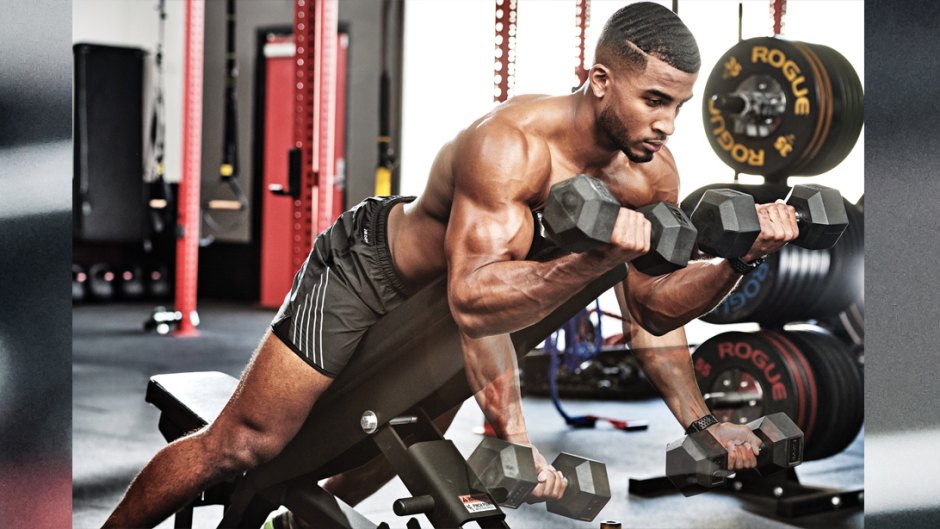Here’s what you need to know…
- Choose a training split based on your goals, schedule, training age, energy system requirements, and ability to recover.
- Body-part splits can be time consuming and impractical for those with fluctuating schedules. Great for size gains though.
- Total body training is better for athletes.
- Push-pull routines are flexible. The moderate frequency of movement is better for skill acquisition than body part splits.
- The intensive/extensive split is based on the neural demands of a workout. A heavy/explosive day is followed by a metabolic/high-volume day.
- Agonist/antagonist supersets work opposing muscle groups together, such as doing a bench press and a row.
- Hypertrophy specialization programs bring up lagging body parts. Focus 3+ days per week on one body part with one day per week for maintaining everything else.
The Best Training Split… For You
There’s no “one size fits all” when it comes to workout splits. Your training depends on your goals, energy system requirements, schedule, and individual differences.
That being said, let’s review the basic, proven splits for successful training. You decide which one fits your needs.
1 – The Body Part Split
Body part splits are your typical “bodybuilder” split. In most cases, lifters attack each muscle group throughout the week in 5 or 6 training sessions.
Pros
Body part splits use greater exercise variation to target individual muscles. They’re great for “shocking” muscles into growth due to high-localized volume, especially for lifters that typically train in total-body style routines.
Increased volume and metabolic stress lead to greater hypertrophy than other splits. Just make sure you have a significant training base before jumping ahead.
Cons
It’s difficult to train with heavy multi-joint lifts without some degree of hindered recovery from previous workouts. You better have your workout nutrition, sleep needs, and other recovery essentials taken care of.
Body-part splits are time consuming and impractical for busy people with fluctuating schedules because missing one routine throws off the flow of the program. Many body part splits “major in the minors” and are cosmetic based rather than performance based – not the best option for athletes or beginners.
Example
- Monday: Chest
- Tuesday: Back
- Wednesday: Shoulders
- Thursday: Legs
- Friday: Arms/Abs
- Saturday/Sunday: Off
2 – Upper-Lower Training Split
Upper-lower training splits are a novel progression for those accustomed to total-body training splits as they allow more recovery and training volume. Upper body and lower body days are alternated for 4 workouts in a 7-day training split.
Pros
Upper-lower training splits are a great progression from total body training and work well with most populations that want to gain size and strength concurrently.
Upper-lower splits allow greater training frequency for quicker learning and mastery while still using significant loading. They offer a moderate training frequency and moderate-high volume for hypertrophy.
Cons
They often present generally unbalanced training times with upper body workouts taking much longer than most lower body sessions.
Upper-lower training splits offer shorter recovery time between training sessions compared to body-part splits, which may hinder recovery. Lower body training is brutal; doing it two times per week might be too much for the weak minded.
Example
- Monday: Upper Body (Push Strength Emphasis)
- Tuesday: Lower Body (Squat Pattern Strength Emphasis)
- Wednesday: Off or Active Recovery
- Thursday: Upper Body (Pull Strength Emphasis)
- Friday: Lower Body (Hinge Pattern Strength Focus)
- Saturday/Sunday: Off
3 – Total Body Training Split
Total body training splits are maximally efficient and train the body as a unit rather than its component parts.
Pros
Total body splits are for those short on time who want full-body stimulation. High frequency stimulation of muscles and moderate training volume suits many goals, such as fat loss, strength building, and hypertrophy.
Total body training is better for athletes and allows easier integration of movement training. Minimized “fluff” forces workouts to focus on essential items, not 13 variations of lateral raises.
Total body workouts are great for beginners, fat loss, and general health. It’s easy to integrate other training modalities around total body routines as most movements and muscles are hit during each workout.
Cons
Low intra-workout volume may hinder metabolic-stress related hypertrophy. Stronger lifters may struggle with recoverability from training legs 3 times per week.
It’s difficult to train more than 3-4 times per week without knowledge and self-awareness for auto-regulation. Also, smaller “show” muscles are likely neglected, which is tough on the closet bodybuilder psyche.
Example
Monday
- A. Power Clean 5×3
- B. Bench Press 3×6
- C. Lunge 3×8-12
- D1. Farmer Walk 3×30 seconds
- D2. Dip 3x 30 seconds – timed set
Tuesday
- OFF
Wednesday
- A. Push Press 5×3
- B. Deadlift 4×6
- C. Chin-Up 3×8-12
- D1. Plank 3×30 seconds
- D2. Biceps Curl 3x 30 seconds – timed set
Thursday
- OFF
Friday
- A. Back Squat 5×3
- B. Bent-Over Row 4×6
- C. Dumbbell Bench Press 3×8-12
- D1. Kettlebell Crosswalk 3×30 seconds
- D2. Hip Thrust 3×12
Saturday/Sunday: Off or Conditioning
4 – Push/Pull Training Split
Push/pull splits break training up by movement pattern. The movements on the posterior side of the body are predominantly responsible for pulling actions while the front/anterior side of the body is responsible for pushing actions. Legs are often paired on “pull” days.
Pros
Push/pull routines are suitable for intermediate-advanced trainees. They’re an economical way to train and allow for flexible planning. Moderate frequency of movement is better for skill acquisition than body part splits performed once per week.
Cons
Push/pull splits are of limited use with athletic populations because they segregate the body by muscles that work together. Push-pull routines are also a bit advanced for beginners who want to maximize their gains.
Example
- Day 1: Pull (legs/hamstrings, back, biceps, lower back)
- Day 2: Push (chest, shoulders, triceps, legs/quads, abs)
5 – Intensive/Extensive Training Split
The intensive/extensive split bases training on the neural demands of a workout. For example, a heavy/explosive day is often followed by a metabolic/higher volume day. Three or four days of training often work best.
Pros
Intensive/extensive splits are an advanced programming strategy for athletes who want to take the next step. They’re great for athletic populations and for training movement skills (like acceleration) in coordination with resistance training. They also offer a sound progression for developing greater levels of performance.
Cons
Intensive/extensive splits are advanced and complicated to design. They may not be ideal for hypertrophy-oriented lifters because splits are focused on the inclusion of movement training, which may be detrimental to overall recovery for hypertrophy. Workouts are longer in duration on intensive days due to the neural recovery demands of intense exercise.
Example
- Monday: Speed work, Olympic lifts plus compound push exercises
- Tuesday: Metabolic/change of direction, pull emphasis
- Wednesday: Off
- Thursday: Speed work, Olympic lifts plus compound push exercises
- Friday: Metabolic focus, pull emphasis in weight room
- Saturday/Sunday: Active Recovery
6 – Primary Mover Plus Opposing Supersets
Also known as non-competing supersets or agonist/antagonist supersets, these splits work opposing muscle groups together. An example would be doing a dumbbell bench press and a chest-supported row.
Pros
Non-competing supersets are good for building muscle and achieving a one-to-one training balance on opposing sides of the body. Increased blood flow to antagonist muscle groups may improve performance and metabolic stress-related hypertrophy.
Non-competing supersets are flexible and can allow for 3-6 days of training based on training age. Supersets are easily done to maximize training efficiency.
Cons
Difficult to integrate movement skills, making it difficult for athletes to incorporate non-competing supersets as a primary method. They’re a bit advanced for beginners and may pose recovery problems for older lifters.
Example
- Monday: Chest/Back
- Tuesday: Legs/Shoulders
- Wednesday: Off
- Thursday: Chest/Back
- Friday: Biceps/Triceps
- Saturday/Sunday: Active Recovery or Off
7 – Primary Mover Plus Synergist
These splits combine major movers of an exercise with secondary movers in the same training day. Back and biceps or chest and triceps splits are examples.
Pros
Flexible training frequency with 3-6 days of training per week. Supersets create time-efficient workouts. High training volume yields greater intra-workout muscular damage.
Cons
Advanced for beginners and tough to recover from for older lifters. Variability in training frequency may be difficult for younger lifters to set up.
Example: 5 workouts per week
- Monday: Back/Biceps
- Tuesday: Chest/Triceps
- Wednesday: Legs/Shoulders
- Thursday: Back/Biceps
- Friday: Chest/Triceps
- Saturday/Sunday: Off
8 – Specialization Training Splits: Hypertrophy Specialization Programs
Specialization programs focus on bringing up a lagging body part within a short time frame. This involves focusing 3+ days per week on one body part with one day per week for maintaining other body parts.
Pros
Specialization workouts jump-start stagnant gains on a body part. High volume and frequency result in a dramatic increase in hypertrophy on the specialized body part. They’re often a blast and great for more advanced lifters.
Cons
Specialization workouts neglect other body parts during the program, potentially leading to atrophy and a decrease in performance. Specialized programs are unbalanced, making it hard to maintain other fitness parameters.
Example: Back Specialization
- Monday: Low-Rep Horizontal Pull
- Tuesday: High-Rep Vertical Pull
- Wednesday: High-Rep Horizontal Pull
- Thursday: Low-Rep Vertical Pull
- Friday: Total Body Maintenance

So Which Split Should I Choose?
Determine Your Main Goal
Your goals must be clear. Focusing on isolation isn’t ideal for athletes, as they need to move the body as an integrated unit.
If your aim is to get as big as possible, then you don’t need to spend time perfecting a sprint mechanic. Make your goal as specific as possible and then tailor your training split as needed.
Assess Your Schedule
Regardless of how busy you are, you still have the same 24 daily hours the rest of us have. I’ve trained a client with three kids, an hour commute to work each day, and 5-6 twelve-hour workdays each week – and he still finds a way to train 3-4 times per week.
My point is, you have time, now prioritize. If training 2 hours per day 5 days per week isn’t ideal for you, pick a more efficient split. A workout is only as good as its execution. Determine what you’ll do and then execute it.
Training Age
Training age is a highly variable but important factor in training.
Beginners jump on body part splits and isolation workouts before they’re strong enough to reap the rewards of focused isolation. Older lifters find they can’t train as hard as often due to greater neural requirements, joint stress, and recovery.
Recoverability
The body is an integrated system. Rather than looking at recovery based on how your muscles feel, you must take into account everyday stress, the nervous system, sleep quality, and nutrition.


